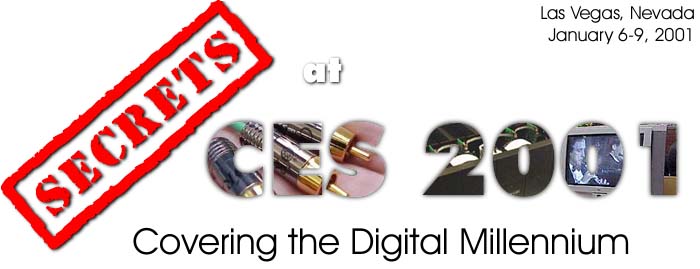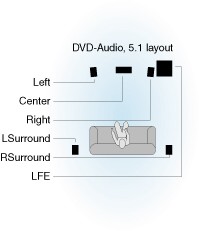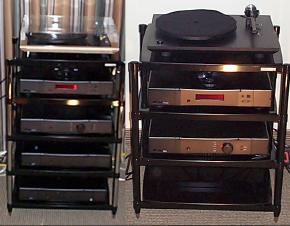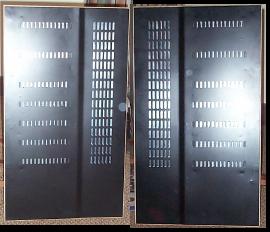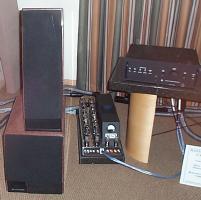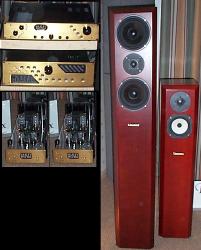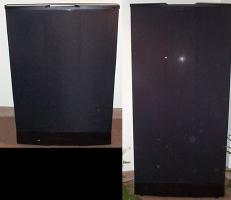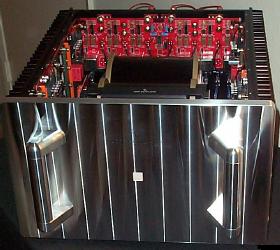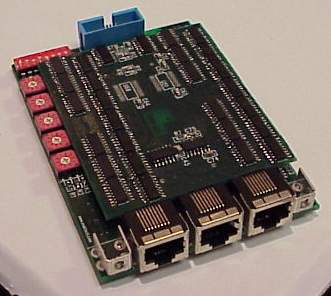|
|
|
|
|
Report Wrap-Up |
Below are final notes and photos from the writers who attended the show: Brian Florian:
Topics which seemed prevalent this year were DVD-Audio, Pro-Logic II (DPL-II), and SACD. I sat down with Dolby's Brent Butterworth to discuss the first
two.
What is most promising about the DVD-Audio format is that it can have two
'zones', i.e., a DVD-Audio Zone and a DVD-Video Zone. The Video Zone is 100% compatible with the myriad of DVD-Video
(DVD-V) players already out there. The
reason this is so significant is that Dolby is encouraging the studios to include a Dolby Digital 5.1 copy of the album in the Video Zone. In so
doing, people who have yet to purchase a DVD-Audio player can still enjoy the new 5.1 music mix,
although without the MLP quality. - Brian Florian - John Kotches: This was the first time I attended CES and the second show I've covered for Secrets. Because I live in the Midwest, I didn't have time to get all the photos loaded onto our site before I headed out to catch my flight back home. At the end of my wrap-up, I'll have more pictures and captions. Analog is alive and kicking At both the Alexis Park (0fficial home of specialty audio) and T.H.E. Show, vinyl was spinning in many of the demos. Properly done, vinyl still sounds good. Particularly noteworthy were rigs running in the Neat/Exposure/Neuance and the Manley Labs/Coincident Speakers rooms. I couldn't tell you exactly how many turntables were available, but there were far more than I had anticipated. This makes a silver disc guy want to put together a black disk setup again. Sumiko had a static display of the Pro-ject turntable lineup as well. I'm sure there are plenty of others I'm missing, not by intent -- just because I was surprised by the availability of vinyl. Statement Speakers vs. Real World Speakers: That's another popular item that seemed to abound. Off the top of my head were the Wisdom Audio Adrenaline Rushes, Dynaudio Evidences, Impact Airfoils, Avant Garde Trios, Neat Acoustics, and Krell. Seems like everybody has to have one (statement piece, i.e., very expensive), including companies that have typically focused on more affordable speakers, like RBH sound. At the other end of the spectrum, there was a fair number of far more affordable speakers on display. The Wraith electrolytic speakers (ESLs without need for a power supply) ranging from $1,900 for Home Theater wall-mounts to $3,800 for their top of the line 6'x2' speaker. They were able to produce excellent sound using modest receivers and separates. Other (relatively) inexpensive gems included Eminent Technology's LFT-14R2 (under $4,000), and Final Electrostatics ($2,600/pair). PSB introduced a new intro line that will offer a glimpse of what the high-end can sound like at an affordable price for the average consumer. Analog Brutes vs. Digital amplifiers: Speaking of statement products, what's up with these brutish multi-channel amplifiers? I saw several that tipped the scales at well over 100 pounds. There were also several mono amplifiers in that category. The real trend to watch is digital amplifiers. Several examples were there, and the ones I heard sounded uniformly excellent. Those were the Bel Canto EVO 200.4 and 200.6, and the Pulsur Technologies amplifier (they were a neighbor of ours at the show). Pulsur will probably not be marketing under this name in the US, but rather acting as an OEM supplier of parts for digital amplifiers. Also on display but not heard by me were Spectron and Tact Audio Digital Amplifiers. One great feature of digital amplifiers is their very high efficiency, exceeding 90%. No longer will you need to draw 50 watts to output 25; it will be more like 30. Once the content providers, i.e., Record Companies and Movie Companies, get their act together, I can see a time when the reproduction chain remains digital all the way to the loudspeaker. With DSP and a digital amplifier in the speaker, each speaker could be corrected for in-room response prior to amplification. While this may be several years out, such a day will arrive. Meridian is pretty close, but in the end they are using conventional amplifiers to drive their digital active loudspeakers. I get the feeling in a couple of years, they'll be changed over to digital amplifiers as well. Some subwoofer amps have already moved over to digital, and the car stereo market also seems to have a number of them. Multi-Channel Music is here to stay: With Home Theater the rage of the consumer electronics industry, and DVD-A and SACD players hitting the $400 price point, Multi-Channel music is with us for good. Regardless of whether we're talking SACD or DVD-Audio, people will want to use all their speakers as much as possible! You've likely heard poor presentations of multi-channel music; I know I have. On the other hand, if you throw away your biases and listen, the sound can be quite enveloping. I've heard details in multi-channel music that I had not previously heard in stereo. The problem is perspective. Most multi-channel mixes put you right in the middle of the action, with instruments and voices all around. One of the most convincing multi-channel recordings I heard at CES was provided in the SLR loudspeakers room. They were playing a new DMP SACD multi-channel disc, by a favorite of mine - the Bob Mintzer Big Band. The whole band was presented across the front, with the surrounds used only to provide a sense of room ambience. Another convincing multi-channel demonstration was of a symphonic recording with antiphonal chorus. I think it was Beethoven's 9th symphony, 4th movement, and it was in the Panasonic/Technics DVD-Audio demonstration. I also brought along some of my own DVD-Audio discs for an upcoming review, and got nice immersion in EAD's room, even if it was a tad too small for the speakers and amplification they were running. More photos Side by side, shown below, left, are two complete racks of Rega gear. The left side is topped off with the Planar 9 turntable and the redesigned Jupiter CD player, which is now an integrated CD player. The right side is topped with the redesigned Planar 3, now called the P3 along with the Planet 2000.
Eminent Technology is about ready to unleash the diminutive LFT-14R2 on the world, shown above, right. These push-pull Planar Magnetic speakers are able to deliver roughly 40 Hz - 20 kHz from a panel that is about 28" x 13". Retail price is expected to be under $4,000. EAD (below, left) continues their push into the DVD arena with the soon to be released Ultra Progressive Scan DVD and DVD-Audio player. As usual, the silver finish is much more attractive than can be captured in a poorly lit room with a camera. The player has an internal volume control, so it can directly drive an amplifier in a single component system.
Greybeard and Atma-Sphere had a shared presentation. Pictured (above, right) are the Greybeard Model 2W, Atma-Sphere MA-1 Mk II amplifier and MP-3 preamplifier. While the 2Ws are not the last word in bass reproduction, the system itself had a balanced, clean sound. Earlier we showed you the Manley Neo-Classic 300B amplifiers. Shown below, left, is a complete system context. Included in the shot are the Coincident Total Eclipse and Eclipse loudspeakers, the new Manley Steelhead phono stage (1mm, 2mc inputs and fully tweakable to get the last bit of performance from your cartridge) and the Manley Wave DAC/preamplifier.
Paradigm has made upgrades to their subwoofer line (above, right), incorporating new "seismic" drivers with massive voice coils and 3" excursions along with improved Class D amplifiers and servo feedback on two of the models. Shown below, left, side by side are the Quad 988 and 989 electrostatic speakers --- followers to the Quad ESL (57) and Quad 63. Pricing is said to be $6,000 and $8,000 respectively. This was a static demonstration only at T.H.E. Show, so I am unable to report on their sonics. Private listening sessions were available, but time ran out before I could give them a listen.
This shot
(above, right) shows the massive transformers (4) and capacitor banks (6) as well as the striking faceplate on the Jeff Rowland
MC-6 power amplifier. As with other behemoth Home Theater amps, you are advised to use two (or more) people
to move this giant around. - John Kotches - Paul Knutson: Time truly is our most precious resource. I ran out of it at CES and unfortunately had to leave early Monday morning. Two additional days of visiting, listening, and learning would have been great, because the two days I did spend there were a blast. The vibe at CES 2001 was similar to what you feel during your
first day of school. Remember back
that far? The stage is being set
for the upcoming year, and the companies I visited with are feeling equal parts
excitement and anxiety. The cause
of the excitement is obvious, but why the anxiety? Well, the raucous bull market seems to have ended, and the
bears are out of their nearly decade-long hibernation. With less discretionary income floating around, consumer
spending will be more cautious. It
may be that the consumer electronics industry, and more specifically high end
audio, feels the brunt. But there
is so much amazing, cutting-edge (and affordable) high performance audio gear
coming out this year, that I'm predicting a great year for the high end, bear
market be damned. As the newly anointed Editor of Tube Equipment for Secrets, I
try to spend the majority of my time visiting with companies that manufacture
gear that falls into my realm. One
of the things I love about CES is that business gets done there.
The business to which I refer takes many forms, but in our case, it's
arranging equipment reviews for the upcoming year.
Along those lines, CES was a major success.
I won't go through a laundry list of what's on tap for review this
year, because I don't want to jump the gun until shipping details are worked
out and the gear is actually received. Rest
assured, however, that I've got lots of intriguing stuff in store – tube
amps, preamps, high-efficiency speakers, DACs and more.
You are going to love reading about it all. Because of my truncated visit, I didn't have the
opportunity to hear all the demo rooms, so it wouldn't be fair to identify an
overall Best of Show. Besides, show
conditions, as alluded to by other Secrets writers, are typically less than
ideal for critical listening. I'd
be remiss, however, if I didn't mention a couple of the demo rooms I heard
that simply blew me away. The ever-gracious Tash Goka, the North American distributor
of Divergent Technologies, played a pair of high-efficiency Reference 3A MM
deCapo monitor speakers with the Antique Sound Lab MG SI-15DT ($699) tube
integrated amp. The front-end was a
modified Pioneer player that I need to learn more about.
Talk about musical, dynamic, balanced sound – I was astounded at what I
heard from this modestly priced combination of equipment.
Joseph Lau of Antique Sound Lab was also on hand to respond to technical
questions about this exceedingly exciting lineup of affordable tube gear.
If all goes as planned, we will have lots to tell you about these
products in 2001. Vince Christian, Ltd. speakers and Birdland Audio teamed-up
for a room that proved to be absolute ear candy for me.
The VC E6 Studio Deluxe speakers ($3,500) and B12WP ($2,500) bass module
threw a marvelous soundstage with lifelike transients and tremendous coherency.
Could it be the use of a series crossover? Perhaps that's part of the magic. I've heard similar things from other series-crossover
speakers before. The speakers were
powered by a prototype 35 wpc amp from Birdland Audio (hopefully this prototype
becomes reality at some point) and their Odeon Lite DAC. Positively a treat. One tube amplifier manufacturer that you are going to hear a
lot more about in the near future is deHavilland. They played their new Aries-845 monoblock amps with
Buggtussel speakers, and man, was it ever impressive!
Kara Chafee has designed a potential groundbreaker with the Aries-845 –
we plan to cover this amp in detail for you soon. Space and word limits prohibit me from going on and on about
other rooms I enjoyed. But I've
just gotta' list some manufacturers that, based on what I heard, are worthy of
your time and effort to keep an eye out for what they have on tap in 2001:
Joule Electra, Loth-X, Silverline Audio, Manley Labs, Merlin, Wavelength Audio
and more. CES was great kickoff to the year in high-end audio, now stay tuned for a fun 2001. -
Paul Knutson - Colin Miller: There didn't seem to be a whole lot of the spanking new. Most of the
encouraging things that I saw were a maturation of previously introduced technologies, such as better Plasma and DLP displays, the gradual
delivery of promises past, such as DVD-A material and SACD players, and a very slight
shift in the industry away from the status quo. - Colin Miller - John Johnson: Although there was no major new technology presented at this year's CES, most manufacturers were showing products that incorporate the technology that already has been developed in the last few years, such as DVD-A and HDTV. To me, that's a good thing. It means the products are finally catching up to the available technology, and consumers will be able to get them at good prices. Fujutsu told me they think plasma screen technology will max out at around 100" sized screens. That is more than 8 feet. If it happens, and the screens are less than $10,000, and the image quality continues to improve, the industry can count on most people wanting one over a conventional rear screen projection TV. Digital amplifiers are really coming out now. I see their use not only in high-performance audio, but in the mass market industry, where the existing sized power supplies would be able to give us much more power at the speaker because the digital circuits are so efficient. As to DVD-A and SACD, Sony is now releasing a multi-channel version of SACD. They should have done this in the first place. Although the two formats are extremely competitive with one another, I think the only real course is to allow DVD player manufacturers to incorporate both formats into their decoding chips, just as DD and DTS are now. Then each faction can release their music, and consumers would buy both types of music. If they continue to fight each other, well . . . let's put it this way: would you buy two players just so you could play both formats? Me either. On the other hand, we may all just have to go to someone like MSB Technology, who is already making upgrade boards you can have installed into your DVD player that will then output 24/96 DVD-A in digital form, which you can then feed to an outboard DAC. The big consortiums won't allow the player manufacturers to put a board like this in at the factory, but with MSB, you are essentially hiring them to do this for you. The upgrade card is $599 installed. Here is a picture of it (below). It uses Cat 5 output jacks (like the ones we use for network cards in our PCs). This is because standard SPDIF jacks (such as RCA jacks) won't handle the high frequencies needed with 24/96 and 24/192 digital bitstreams. You can see the three Cat 5 jacks on the bottom of the card. If MSB or other companies can supply us with the necessary upgrade, which may include a change in the actual drive mechanism, that will allow us to play DVD-A and SACD on one player, for $1,000, I imagine many of us would place the order.
Denon is licensing those wonderful animated graphics that Brian Florian (Secrets Editor, CANADA) designed for one of our DVD Benchmark articles. They want to use the graphics for teaching courses to their dealers about DVD player functions. Denon is also joining Secrets as a sponsor. ButtKicker, whose product we reviewed last year, had a booth 4 times the size that they had at CES 2000. There were so many people there, I could hardly get into their booth. They have some major players negotiating for licensing their technology, which includes such things as a 26" subwoofer, driven by the 3 pound cylinder in their ButtKicker shaker. The intensity of this large subwoofer was almost shaking the entire auditorium. In fact, it was so loud, I figured this company is developing killer products, so I asked them to join us as a sponsor. They agreed, and their logo is on our pages now. We had several venture capitalists come by the booth and offer financial support to develop new sections in Secrets. I can't tell you about them right now, of course, but will let you know as they are firmed up. We even had a vice president of one of the major TV networks make a point of introducing himself to us, so our little journal is moving up to new plateaus right on schedule. - John Johnson - Stacey Spears: A new year is upon us and another CES has gone by. What was the
highlight of the 2001 CES for me? I think it was probably the Krispy Kreme doughnuts located in the Excalibur hotel across from the NYNY where we were staying. The NYNY actually had a small Krispy Kreme
located upstairs, but the doughnuts were brought over from across the street. Anyone who is familiar with Krispy Kreme knows you must get them fresh
off the conveyer belt, and they simply melt in your mouth. - Stacey Spears - Jason Serinus: When I attended my first CES over a year ago, I arrived with
the naďve notion that by playing something from my favorite stack of demo CDs,
I would get a decent sense of how a chain of equipment sounded. I did not
understand that CES exists far more for marketing to dealers and distributors
than demonstrating to reviewers and consumers. Talk, product, and business
agreements reign supreme at CES; listening is secondary. No wonder that some
manufacturers don't even bother to play music, while others use it mainly as
background for wheeling and dealing. When I wrote my CES 2000 show report for a different magazine,
I actually critiqued the sound in many of the rooms I visited. I named names,
and there were lots of negatives. My esteemed editor cut most of my critical
comments, assuring me that, under the difficult Alexis Park/St. Tropez
conditions of small rooms and minimal set-up time, the disturbing things I heard
were not necessarily indicative of anything more than a manufacturer's lack of
time and sleep. This year, I found his attitude correct. I left both my CDs
and my expectations of hours of uninterrupted, blissful listening back home in
Oakland. Instead, I arrived determined to visit key manufacturers with whom I
wished to make contact, and acquire equipment for a year of reviewing. I
especially focused on speakers and amplifiers, because these are the two items
in my system that I wish to eventually upgrade. I talked over music like the
rest of them, listening only in small snatches. I knew that it would be rare
indeed to hear sound the equal of what one could achieve with sufficient
break-in and set-up at home. Many of the rooms I visited exhibited a smooth, somewhat
shiny sound, almost as if all the instruments had been coated with either Mylar®
or some thin viscous plastic. It was a very seductive sound, but it was
certainly a case of “Mirror, mirror on the wall, where's the real music in
this hall?” Perhaps it was sound the designers sought after, but it sure
didn't seem natural to me. As the days passed, I found myself longing for the
sound of my extremely neutral Pass Aleph 5. Though the Pass' bad impedance
match with my preamp only compounds its dearth of brilliant highs and deep bass,
my Aleph 5 has long been pardoned because its extremely relaxed neutrality lets
me sink into the “ah” of music. One set of speakers which I will definitely be reviewing, and
which four reviewers have now bought as their reference, didn't sound great at
all on the first day at the CES. Neither did the new reference amp/preamp combo
for a highly-trusted reviewer. Fabled electronics sounded, well, electronic.
Another amp/preamp chain that I will be reviewing before long sounded very
different than when connected chez Serinus, leaving me cringing at the resonance
on a soprano's high notes. Most disappointing of all was a highly lauded, new
iteration of a fabled set of speakers . . . speakers which have, at one time or
another, served as references for countless reviewers. Many of my colleagues are
now singing the praises of this new edition, and I have no reason to question
either their hearing or their integrity. Nevertheless, these speakers (which I
hope to review), when displayed in front of a huge mirror and connected with
inferior cabling, emitted highs which grated the ear far more than those from
many a $29.95 clock radio. As for the bass, it made my Pass sound like a Krell. But I know better than to judge equipment by what I heard at
the show. Reviewing is about taking all the time necessary to fully appreciate
the strengths and weaknesses of a component, and to convey that to the listener.
This I plan to do for you in the coming year. Most impressive were the warmth and excitement of various
designers and manufacturers. Bill Low of Audioquest graciously gave me a ride to
the Golden Nugget, and shared his philosophy about the future of two-channel
sound and the high-end in general. Caelin Gabriel was just plain super, as was
Michael from Talon. (I write this not yet unpacked, with cards and names buried
under piles of review CDs.) It was great to meet Steve McCormack, and to sense
him understand and connect with where I'm coming from, and where my heart is, as a music lover. Robert Stein and Steve
from the Cable Company were great, and the fabled Bob Cohen somehow managed to
survive even more questions from yours truly. The bright-eyed Paul McGowan was
on a much-deserved roll once again. The owner of NHT sat next to me on my plane
ride home, and offered to show my around his facility in Benicia. Finally, the
great and generous Mark Schifter proved himself, once again, the great Mark
Schifter of Perpetual Technologies. Sonically, the most impressive demo I heard was Perpetual Technologies' comparison of the B&W Nautilus 802s with and without P-1A speaker correction. The 802 is a fine speaker to begin with – I'm hoping to review a pair – but it sounds even better with correction. Most striking were the increase in depth and veracity, with images sounding far more rounded and natural, and the air around them sounding far more like what would encounter “in the hall.” I very much look forward to applying Perpetual Technologies' speaker correction technology to my present and future speakers, just as I look forward to the eventual issue of their P-5A, one-piece DAC that interpolates and upsamples to 24/192, plus offering all the features of the current P-1A. Update
on Experiences with the PS Audio P300 Power Plant It happened again. For the second time in three months, at
least one of my tubes burned out in my Bruce Moore Companion III preamp. This
time, whenever the preamp had been cooking for awhile, the left channel almost
totally disappeared. What could be causing such rapid tube deterioration, I
wondered? When I mentioned the problem to our own Stacey Spears, he told me
he had discovered that, with certain MultiWave settings, output voltages reached
130 or above. Since most U.S. equipment is made to operate with no more than 120
volts, we speculated that excessive voltage might well have contributed to
premature tube failure. While at CES, I raised the voltage issue with Paul McGowan.
Paul told me that voltage output of the MultiWave-equipped Power Plant is
adjustable once one is in voltage mode. On my P600, the voltage mode is the
second of the three mode settings available by toggling the right “Mode”
button on the front panel. The first position allows selection of the MultiWave
combination, the second the voltage. The third provides a highly inaccurate
display of the amount of watts equipment connected to it consumed – the
actually amount is far greater – and the fourth dims the front panel.
Depressing the button once more returns you to the MultiWave selection mode. Unfortunately, the displayed voltage number, which is set at
the factory to 117, is not the voltage the Power Plant outputs in any other than
Sin mode. Voltage output varies greatly depending upon the chosen MultiWave
setting. In the MultiWave PS2 setting, for example, a Power Plant front panel
which displays 117 in voltage mode is actually outputting 130 volts! Once in
voltage mode, voltage output must be adjusted by hand in order to keep it within
safe limits. None of this information is supplied by PS Audio in its
literature. It just so happens that, when I set the Power Plant to
optimal SS1 MultiWave mode, the power supply in my Theta DAC emits a low
whirring sound. When not listening to music, I had begun setting the Power Plant
to PS2 mode, which does not cause whirring. Unfortunately, this was resulting in
an output of 130 volts to my preamp's tubes. No wonder the tubes were burning
out! When I asked Paul McGowan what I should do, he replied,
“Have Stacey Spears go through each MultiWave setting and measure the voltage
output for you. Once you set the correct voltage for the MultiWave setting
you're using, things should work fine.” Less than 48 hours after returning from CES, Stacey completed
his measurements. This information follows. I encourage you to share his
findings with all MultiWave users by sending them the URL for this page. Voltage
settings for the MultiWave Power Plant
Mode FP117
115
117
120 ------------------------------------ Sin
116
116
117
120 ------------------------------------ SS1 121
111
113
116 ------------------------------------ PS2 130
103
105
108 ------------------------------------ SS3 122
111
112
115 ------------------------------------ SF4 116
116
118
119 ------------------------------------ SSS 130
104
106
109 ------------------------------------ SS6 130
104
105
108 ------------------------------------ SF7 116
116
118
120 ------------------------------------ SF8 116
116
118
120 ------------------------------------ SF9 116
116
118
120 ------------------------------------ The first column lists all the possible MultiWave settings plus the basic default Sin, which deactivates MultiWave. The second column shows the actual default voltage of the P600 when the front panel's voltage mode setting displays 117. The next three columns are the values you need to set on the front panel to actually get the Power Plant to output 115, 117, or 120 volts. I heard SACD demos both at the Sony SACD Pavilion at the San Tropez, and at the Philips booth in the Convention Center. Both were impressive. But even though Sony offered a large space, filled with five B&W 801s connected to expensive electronics, the Philips comparison between two-channel CD and two-channel SACD proved most revealing. Certainly I would expect SACD to sound worlds better than 16/44.1 discs played through a $2,000 Philips player equipped to reproduce standard as well as SACD two-channel formats plus SACD multi-channel. Nonetheless, the SACD formats allowed me, in a far less-than-high-end set-up, in a space surrounded by convention noise, to reach deeply into the soul of the music at hand. There can be no greater reward than to touch the heart of beautiful music. In Conclusion I found myself quite impressed with the energy of John, Susan,
and Cynthia Johnson, and the rest of the Secrets staff. Most of the staff are
from a later generation than John and yours truly, and approach music, and life
in general, in a different manner. The majority of our writers are soft spoken
and self-effacing, drawing virtually no attention to the fact that they are
highly respected, if not acknowledged as geniuses, in their fields. While I may
not join them in the “ButtKicker” seat, or find myself involved in the details
of their worlds, I have fast grown to respect them as individuals of capacity and
integrity. We have a fine crew here, one that will serve you well in the years
ahead. - Jason Serinus -
Click on links below to go to the photo pages for each day. |
|
|
|
© Copyright 2001 Secrets of Home Theater & High Fidelity |

